Connections Card Game ™
Updated 2017-May-25 (New Match One Game)The Connections Card Game is all about finding or making logical connections between words. This card game can be played on any flat surface like your kitchen or classroom table - even the floor.
There are 124 cards, each card having a point value and four unrelated words, one per edge, for a total of 496 English words.
Play the Game like Dominoes
Connections are made by logically matching a word on the edge of one card with a word on the edge of any other card.
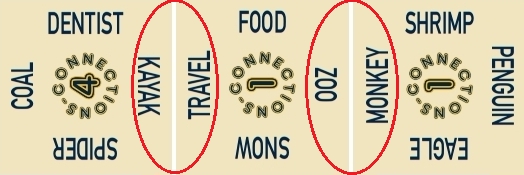
Connections must make sense! If someone has to tell a story to explain a connection, it probably isn’t one.
Simple as that is, there are several ways to play and keep score.
ALMOST 20 WAYS TO PLAY
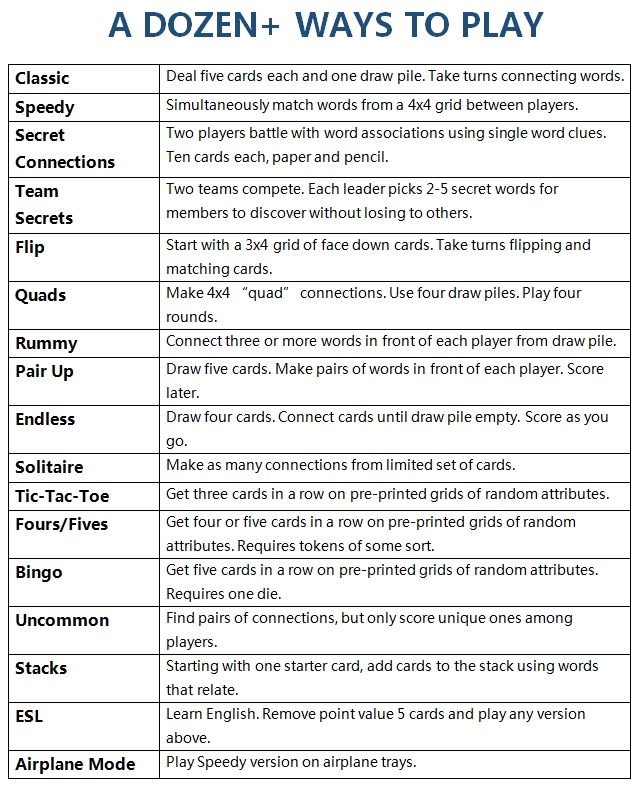
VIDEO INSTRUCTIONS Learn to play BASIC MODE on YouTube.
BASIC GAME
Shuffle the cards and place the pile face down on your table. Draw one starter card and it place face up in centre. Each player gets five or six cards and then takes turns making connections on the table. If a player cannot make a connection within one minute, they draw a card and the turn goes to next player. The game ends when one player has connected all of their cards. That player gets the points of the remaining players’ cards. Continue with another round, either using the existing grid or start fresh. Final high score after five rounds decides the winner.
Note: When playing with autistic children, give everyone one card instead of five, and keep drawing new cards as needed.QUICK PLAY GAME
Objective: be the person with the most points.Shuffle the cards and place 15 or 16 cards face up in a grid. Place all or a portion of the remaining cards face down as the replenishment pile.
Each player takes turns calling out two words on different cards that are related. If the connection is valid, the player removes the two cards, placing them in front of the player. The two missing cards are replaced. If the connection is not valid, the player loses their turn.
The game continues until all cards have been played. Each person adds up their points and the player with most points wins.
Strategy: try to go for cards with most points first.
This version is also good for those with dementia and autism, as it presents fewer choices.
MATCH ONE GAME
Objective: be the person with the most points.Shuffle the cards and place nine cards face up in a 3x3 grid. Place all or a portion of the remaining cards face down on top of the centre card as the draw pile. This gives players 32 words to examine and attempt to match.
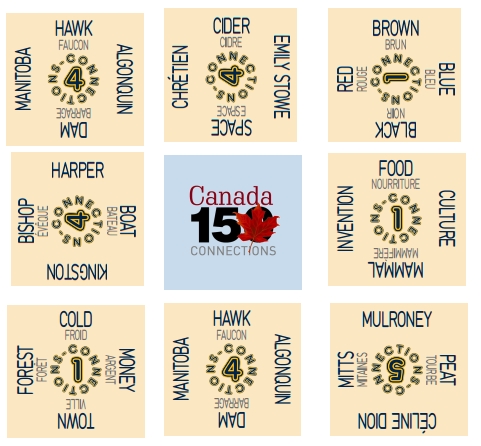
Each player takes turns picking up one card from the draw pile and tries to match one of the four words on that card with one of the 32 words in play. When a match is found, the player calls out the two related words for acceptance by the other players. If valid, the player takes the two cards and places them face down in front of the player. The player then draws two cards from the draw pile, keeps one and places the other card as the replacement in the grid. If the connection is not valid, the player loses their turn.
If no one can find a match, then replace one random card with the next one from the draw pile.
The game continues until all cards have been played from the draw pile. Each person adds up their points and the player with most points wins.
Strategy: try to go for cards with most points first.
SECRET CONNECTIONS FOR TWO PLAYERS
Objective: collect cards and get more points than your opponent.Prep: two pens and papers are required to write down clues and words.
Create two columns on each sheet labeled CLUE and WORD.
Shuffle the cards and give each player ten "secret" cards face down. The remaining cards are not used in this round. Declare how many rounds you will play, each round consisting of both players giving and guessing.
At the start of each round, both players secretly view their own cards one at a time. To save time, both players do this preparation at once. From each card, select a single word and write it down under the WORDS column. Keep each card face down after selecting your word. After writing down all ten words, examine them and write down a SINGLE one word clue adjacent to each word.
We suggest three minutes to perform this operation. The players' papers will end up looking something like this:
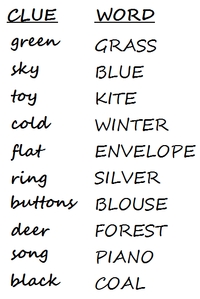
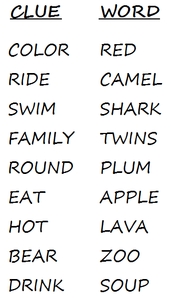
NOTE: You must write down non-contentious, valid clues. If there is any conflict, a player will forfeit their card.
Game Play: When both players are ready, one player shuffles and flips over their cards and gets a brief 15 seconds to review them to strategize the order of presenting the clues.
For each of the ten words (one at a time), the player says one of the clues and waits for the opponent to select a word. The opponent gets up to 30 seconds to review the cards and pick a card with what they think has the correct word.
If the word is correct, the player says "CORRECT" and the opponent claims the card with that word.
If the word is not correct, the card stays in play. The player does not need to explain anything yet.
At the end of ten clues, whatever cards remain go the the player giving the clues. That player must now reveal the clues for the remaining words and perhaps explain. If the clue is deemed invalid, the card goes to the opponent.
To complete the round, reverse roles with the other player to give the their clues.
Play as many rounds as you like, then add the points on the claimed cards to declare a winner.
This game is made very interesting because of ambiguity of clues and words. The opponent will often have to choose between several words related to a clue.
Tips:
- Use attributes and specific categories as clues (round, blue, cold, float, liquid, water).
- Avoid generic clues like animal, plant, movie, book.
- You may encounter a word that is the same as a clue. That's fine.
- Movie and books titles are not allowed (as you can have one on any subject).
- Be as ambiguous or tricky as you like, but be fair with your clues.
- After saying the clue, draw a line through the clue and word.
- Keep the cards you win face up so as not to confuse with the secret cards.
- Take note of which words have higher points as you may want to strategically give their clues first.
TEAM SECRETS FOR POINTS
Objective: be the team with the most points by guessing secret words. This is a collaborative and fun game that should improve extended thinking and working as a team.Prep: a pen and paper is required to write down secret words. Choose two teams with at least two players per team. See alternative below for three people version.
Shuffle the cards and place at least 15 cards face up in a 5x3 grid. You may have as many cards as you like, such as 4x5 or 5x5 grid. Place all or a portion of the remaining cards face down as the replenishment pile. A smaller pile means a shorter game.
Each team alternates turns and different team members alternate being a team leader for each turn.
On each turn, the current team leader will try to get their team to guess the secret word(s) that relate to a word he/she will call out as a clue.
The team leader:
- examines the words grid looking for concepts and themes for related words
- picks a secret clue word
- finds one or more words that will relate to a clue word
- writes down the secret word(s) on the paper
The team leader then calls out a single clue word and the number of secret words written down.
The team then deliberates for a short while and calls out the words that they think match the leader's secret words. The cards with those words are moved to the side.
The team leader reveals the secret words and compares them against the words picked by the team.
There are three things to consider:
The team keeps only those card(s) with words that match the secret word.
The cards not picked, if any, and cards wrongly picked, if any, go to the opposing team.
The missing spots in the grid are replaced with cards from the draw pile.
Team cards are maintained face down in front of each team and later scored.
The game continues until all cards have been played. The team adds up their points to determine which team has won.
TIPS: don't use categories like animals or plants. Use attributes instead like round, red, female, sticky, etc. Avoid words in your attribute that are not on the same card. Compound words (eg BLACK + LIGHT) are allowed.
TEAM SECRETS FOR MOST CARDS
Objective: be the team to win the most cards. Prep: a pen and paper is required to write down secret words.Play is similar to TEAM SECRETS FOR POINTS, except for the following rules:
- Scoring is by number of cards won
- a smaller grid such as 3x3 or 3x4 is used.
TEAM SECRETS WITH THREE PEOPLE
Play is similar to TEAM SECRETS, except for the following rules:In rotation, two players team up against the other player. The player giving the clue collects no cards. The player guessing receives matching cards. The other player receives the unmatched cards. Two players alternate being both sender and receiver before moving to the next player. That way each player becomes the opposing team.
FLIP
A quick game that requires memory and concentration.
Objective: get more points than your opponent.Shuffle the cards and place face down in either a 3x3 or 4x4 grid. Place all or a portion of the remaining cards face down as the replenishment pile. A smaller pile means a shorter game.
On each turn, the current player flips over two cards and has 30 seconds to determine if there are two words on the two cards that relate. If so, the player calls out the connection (for validation) and keeps the two cards. The player replenishes the missing cards face down. If not, the player simply flips the cards back. Play goes to the next player.
The game continues until all cards have been played. Each player adds up their points to determine a winner.
TIP: Try to remember cards with most points.
OPTION: Flip three cards instead of two, but match only two words.
MATCH ME
Quick game.
Objective: get more points than your opponent.Grab a group of cards and shuffle, the give each player four cards.
On each turn, the current player plays one card for the next player to match any word on that card with a word on a card in hsi/her hand. If match, the player takes the cards and places face down for scoring later. If no match, the current player can keep the card or replace the played card. All players must always have four cards in their hand. Play goes to the next player.
The game continues until all cards have been played. Each player adds up their matched points and deduct the points of their four cards to determine a winner.
TIP: Try to play your highest cards.
OPTION: Flip three cards instead of two, but match only two words.
AIRPLANE MODE
A short game that is played on an airplane tray with 2-4 players.
Objective: get more points than your opponent.Shuffle the cards and place face up in a 3 x 5 or 3 x 3 grid on the centre tray. Place the remaining cards in the box on your tray.
This game is played like QUICK PLAY, matching pairs of words.
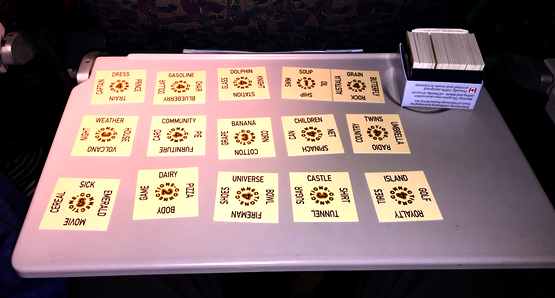

COMPLETE THIS SENTENCE
Objective: be the team with the most points by guessing mystery words. Prep: a pen and paper is required to write down secret words. Choose two teams with at least two players per team.Shuffle the cards and place at least 15 cards face up in a 5x3 grid. You may have as many cards as you like, such as 4x5 or 5x5 grid. Place all or a portion of the remaining cards face down as the replenishment pile. A smaller pile means a shorter game.
Each team alternates turns and different team members alternate being a team leader for each turn.
On each turn, the current team leader will try to get their team to guess one secret word that complete a sentence he/she will call out as a clue.
The team leader:
- examines the words grid looking for concepts, attributes and themes for related words
- avoids generic categories like plants and animals (be more specific, eg mammals)
- makes up a short and simple sentence using one of the words
- the sentence must be in the form "I [verb/verb phrase] [adjective] [secret word]", for example "I visited the dark [what] ?"
- writes down the secret word on the paper.
The team leader then says the sentence without the secret word. For example if the secret word is tunnel, the leader calls out "I visited a dark what?".
The team then deliberates for a short while and calls out the word that they think completes the sentence. The cards with those words are moved to the side.
The team leader shows the secret word and compares them against the words picked by the team.
If the word is correct team keep the card with the word that match the secret word. Otherwise the card goes to the opposing team. The missing spot in the grid is replaced with a new card from the draw pile. Team cards are maintained face down in front of each team and later scored.
The game continues until all cards have been played. The team adds up their points to determine which team has won.
TIP: Avoid picking only highest value cards.
ATTRIBUTES
Objective: be the person with the most points from matching cardsPrep: Use your mobile device with an internet connection. Start the Attributes App. Shuffle the connection cards and place down down in a pile. Deal 10 connection cards to each player.
Note: Each attribute card has a value, there are several cards for each attribute worth 1, 5, 10 points, eg ROUND x 10 yields ten times your connection card points.
Game Play: Click the [NEXT] button in the app to view an attribute card. Each player selects zero, one or more cards with one word that matches the attribute. You do not have to select any cards, either because there isn't a match or because you are holding off for higher points. These are revealed. Add up the points and multiple times the attribute bonus value. Record the score.
Attribute cards marked with "BEST CHOICE" force a player to play only ONE card with only one winner. These usually end in 'EST' such as HEAVIEST, LONGEST, TALLEST. You may not play a card that exacctly matches the attribute card. For example if COLD is revealed, you can play ARCTIC or BLIZZARD but not COLD. NOT card. Arbitrate contested connections via the Arbitration app. Replenish connection cards to maintain 10 cards at all times. Repeat until the deck is exhausted.
Tips: Hold off on some higher point cards for more points
UNCONNECTED (UNCOMMON CONNECTIONS)
Objective: be the person with the most points from unique connections Prep: You will need some sort of timer. Each player must have a pen and paper to write down connections.Shuffle the cards and place at least 15 cards face up in a 5x3 grid. You may have as many cards as you like, such as 4x5 or 5x5 grid. The remaining cards are not used.
Set your timer for three minutes (you may vary as needed). All players examine the grid and find and write down connections they see (in secret).
After three minutes, reveal all written connections. Scratch out connections that are in common with two or more players. Scoring All remaining connections are now "uncommon". Determine the point value of each connection. Add up all points to determine a winner for this round
Repeat for a predetermined number of rounds.
FREE-FOR-ALL GAME
Shuffle the cards and deal 10 cards to each player face up as the first round. The draw pile is kept safe for the next round. All players can now play their cards at any time to make connections without taking turns. First person to play all their cards wins the round and takes the other players cards, placing them face down in front of him/her as their “win pile”. Subsequent rounds are dealt and played until no more cards can be played. When the last round has been completed, the players add up the points in their win piles. The winner is the person with the most points. This is a quicker way to play.
PAIR UP GAME
Shuffle the cards and deal two cards face up to each player. Place the draw pile face up in the centre of the table. In turn, each player attempts to match one of their cards with any one of the other cards that are face up, including the draw pile and any other players’ cards. Once matched, the player keeps the two cards face down until the end of the game. A player must always have at least one card (face up). The game ends when the draw pile is depleted. Each player adds up their matches’ points, deducting any points on their unplayed cards. The winner is the person with the most points.
Strategy is to match most valuable cards first.
RUMMY
The objective is to make "runs" of connected words.
Deal three cards to each player and place the remaining cards in one draw pile face down in the centre of the table. In turn, each player attempts to make "runs" of three or more cards in front of them. A player draws the next card from the draw pile. The player then attempts to make connections with their own words. You are allowed to steal a card from the end of another player's run of four or more cards, but only on your turn. Upon making a run, a player announces the connections and may turn over the cards or attempt to add more cards at the risk of having a card stolen. Each player must always have at least three cards. The game ends when the draw pile is depleted. The winner scores his/her hand. The others add up their cards and deduct what has not yet been played. In turn, each player attempts to match one of their cards with any one of the other cards that are face up, including the draw pile and any other players’ cards. Once matched, the player keeps the two cards face down until the end of the game. A player must always have at least one card (face up). The game ends when the draw pile is depleted. Each player adds up their matches’ points, deducting any points on their unplayed cards. The winner is the person with the most points.
Strategy is to match most valuable cards first.
FOUR PILE RUMMY
The objective is to make "runs" of connected words.
Shuffle the cards and take a large random pile Make four more or less equal piles in the centre of the table face up. These are the draw piles. In turn, each player attempts to make "runs" of three or more cards in front of them.
A player can
Before making a run, a player announces the connection. The game ends when the draw piles are depleted. The winner scores his/her hand. The others add up their cards and deduct what has not yet been played.
Strategy is to match most valuable cards first.
QUADS GAME
A slower, more challenging game of four cards, four piles, four connections, four rounds. The objective is for all players to make their own "quads" of four cards arranged in a square with each to the four inners edges properly connected.
Deal four cards to each player. Split the remaining cards into four equal piles (more or less), face up as the draw piles. Each player must make "quads", which are sets of four connected with four pairs of connections. These are played individually in front of each player. Each quad must be accepted and validated by all players. Players draw cards only from the four centre piles. You may play in turn or simultaneously. You may return cards that you do not want to use.
The round is over when any player makes four quads.
Strategy is to match most valuable cards first.
TIC-TAC-TOE GAME
A way to place the timeless tac-tac-toe game.
Objective: place four tokens in a row or in a 2x2 square.
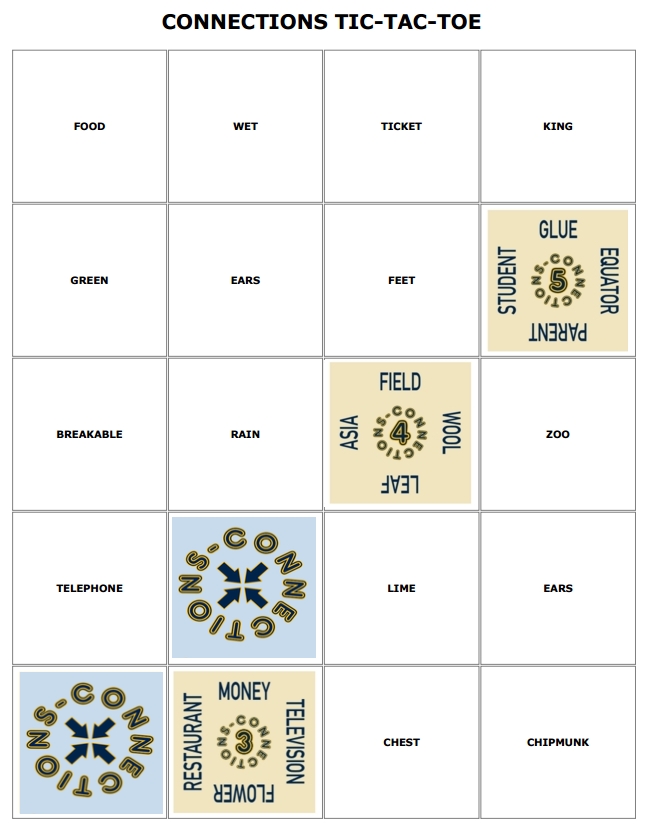
Prep: Using our tic-tac-toe app print off several grids of random words.
Various size grids are available. We suggested the 5x6 grid.
Deal ten cards face down to each player.
Give each player ten identical tokens, such as pennies, rocks, dimes etc.
Players examine their cards. Choose one person to go first. Compete to place three of their cards in any straight line, horizontally, vertically or diagonally onto the grid. You may also play 2x2 sqaure with four together to win.
In turn, each player places one of their cards onto a square whose word relates to any word on any of their cards. For example, if the grid has "WHITE", the player can place the card with "SNOW". If only two players, one player flips their card face down instead. With three or more players, use tokens to identify their card. Use the Arbitration App to arbitrate contested matches.
Play until a winner emerges, or no longer possible to play three cards in any line.
Winning: The first player to get their three cards in any straight line wins the game.
Strategy is to block other players with your cards.
FOURS & FIVES
Token-based game for 2 or 3 players.
Objective: place four or five tokens in a row.

Prep: Using our tic-tac-toe app print off the 5x6 grid or 6x8 grid.
Deal one card to each player.
Give each player identical tokens, such as pennies, rocks, dimes etc, using the formula 30/# of players.
Players examine their cards. Choose one person to go first. Compete to place four or five tokens in any straight line, horizontally, vertically or diagonally onto the grid.
In turn, each player examines their card and places one of their tokens onto a square whose word relates to any word on their card. For example, if the grid has "WHITE", the player can use the card with "SNOW". Use the Arbitration App to arbitrate contested matches. The card may be kept or replaced.
Play until a winner emerges, or no longer possible to play four or five cards in any line.
Winning: The first player to get four or five cards in any straight line wins the game.
Strategy is to block other players with your cards.
BINGO GAME
A way to play the timeless BINGO game.
Objective: be the first person to place five cards in a row.
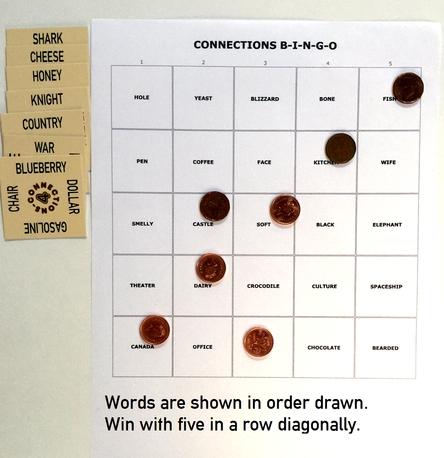
Prep: Using our tic-tac-toe app print off one 5x5 grid per player.
Get one die.
Deal 15 cards face down to each player.
Place the draw pile facedown.
Each player draws the top card. One player rolls the die. All players try to place their card on their bingo paper. The number on the die relates to the 1st, 2nd, 3rd, 4th and 5th columns, except for 6. If a 1-5 is rolled, try to place the in the 1st to 5th column respectively. If a 6 is rolled, place the card in any column.
Play until a winner emerges, where five cards are in any line, horizontal, diagonal or vertical.
COOPERATIVE PLAY
Same rules as any of above, except no scoring. Just play to see how people think.
SOLITAIRE PLAY
Instead of playing in the centre of the table, each player makes their own set of connections in front of them. Same rules as either of the above, except playing with their own set of cards.
WEIRD “BUT POSSIBLE” STORIES
In this funny variation, players have to make up weird stories about each connection. The connection must be plausible, but not necessarily probable. For example connecting COW with VOLCANO, a player could simply say “The cow fell into the volcano. It’s possible!”
Game Play: Place the entire set of card face down in the center of the table. On each turn, two people (other than the current player) draw two cards and say one word. The player must make a story about the connection.
ESL (ENGLISH AS A SECOND LANGUAGE)
Remove the 5 point cards as they have the hardest connections. Play the Classic version. Progress by adding back all the cards.
MARA'S GAME
Mara from Aurora Grove Public School came up with this rapid way of playing. Place any number of cards upside down in a draw pile. Any number of players.
One player draws two cards from the draw pile and quickly places them face up amongst the players. All players look at the eight words to find two words, one from each card, that connect. The first person to call out the connection, takes the cards.
However, the connection must be valid and democracy (thumbs up, thumbs down) rules. If there is no connection, another card is drawn and everyone looks again.
After all cards have been shown, everybody counts up the points on their cards. The person with the highest score wins.
SEVERAL WAYS TO SCORE
You can keep score in a variety of ways:- Score cards as played
- Score at the end of a round by having winner take all players' unplayed cards
- Use the scores for both the card played and its connection(s) (two edges connect)
- Double scores if three cards connected (four edges connect)
- Triple scores if four cards connected (six edges connect)
- Quadruple scores if fives cards connected (fill a hole)

Note: when connecting your card to two or more cards, all edges must match.
POINT VALUES
Cards have been given point values based on how many connections each word on the same card has:- 1 point: more than a dozen connections
- 2 points: around a dozen connections
- 3 points: about ten connections
- 4 points: half a dozen or so connections
- 5 points: only four or five obvious connections.
MAKING LEGAL CONNECTIONS
THAT MAKE SENSE
When connecting cards, the matching words must be related in a very obvious or immediate manner. For example, APPLE can match RED, YELLOW, SEED, ROUND, FRUIT, PLANT, JUICE and TREE but does not match VEGETABLE, KITCHEN, PURPLE or FLY. Ask yourself if they match directly or have a common category (like PLUM could match BANANA as both are fruits).
Direct connections: a PLANT is GREEN, a BOAT is on WATER, a SPIDER is an animal, WOOD can FLOAT.
Indirect connections: a BOWL and PEAS
Common category: a BANANA is like a PEACH because both are plants, RAT and BEAVER are both mammals, both have FUR, both are rodents.
Compound words and phrases: BAT CAVE, EAR DRUM, AIR MAN, ROCK HARD, SUN FLOWER.
BOWL and CUP are both containers but BOWL and PEAS is not a direct connectionCalling it stretch with indirect connections.
You shouldn't have to make up a story to explain a connection.
We eat a COW as FOOD (No, we eat meat not the cow.)
COW is better connected to ANIMAL or FARM.
FOOD is better connected to MEAT or BREAD.
I bought SHRIMP for a DOLLAR (Possible, but not the intended connection for either.)
SHRIMP is better connected to PINK or OCEAN.
DOLLAR is better connected to USA or MONEY.
We went on VACATION and saw a GLACIER (Possible, but not a direct connection.)
BEACH would be the more common connection to VACATION.
VACATION is better connected to TRAVEL.
GLACIER is better connected to ICE or FROZEN.
WOULD YOU ALLOW THESE CONNECTIONS?
CAMEL matches OSTRICH
How?: both have long necks, both are found in Africa
We call that a stretch? Would you?
EXCLUSION RULES
Cannot match a specific animal to any other animal ie both are animals is not allowed
"Both are plants" is not allowed.
"Both are animals" is not allowed.
Movie or Book about anything is not allowed.
Must use attributes or sub categories like fur or mammal or rodent.
However can match rat and mouse small rodents
Cannot match robin and turtle (both are animals).
HAIR is on the head of the QUEEN (True, but there are better connections.)
HAIR is better connected to HEAD or BODY.
QUEEN is better connected to ROYALTY or FEMALE.
A BOOK or MOVIE about another word (topic) is not allowed.
Valid Connections Arbitration AppBONUSES
If someone can legally connect two or more edges to adjacent cards, the scores can be doubled or an extra card collected.
VARIATIONS
Decide in advance upon any of these game play and scoring options:
| [ ] | Initial draw of five, six, seven or even 10 cards |
| [ ] | Use own card or top card of draw pile |
| [ ] | Take turns or play all at once |
| [ ] | Number of rounds to play |
| [ ] | Maximum cards in hand |
| [ ] | Minimum cards in hand |
| [ ] | Allow only direct connections like PEAS and VEGETABLE |
| [ ] | Allow "BOTH" connections like HONEY and GLUE, eg "BOTH are STICKY" |
| [ ] | Allow indirect connections like BOWL and PEAS |
| [ ] | Allow compound words like BREAD BOX |
| [ ] | Allowed to exchange cards from the draw pile |
| [ ] | Allowed to swap cards with another player |
| [ ] | Use entire or partial deck to end a round |
| [ ] | Play two or more cards per turn |
| [ ] | Match two or more words: extra turn or extra card or extra points |
| [ ] | Limit each player’s time to 30 or 60 seconds |
| [ ] | Playing multiple connections in one turn allowed or not allowed |
| [ ] | Scoring per play or end of round with losers' points. |
Connections just have to make simple sense. If the player has to explain the connection or make up a story, it probably is not a valid connection. Poll the players for an opinion and indicate acceptance or rejection with "thumbs up" or "thumbs down". If there is an even number of players, the player with the questionable connection does not participate in the vote.
Use our web app to arbitrate contested connections on our website. Enter both words and the app will indicate the validity of the connection.
CREATIVE THINKING
Card Connections encourages players, especially kids, to express themselves creatively, letting them think about the concepts among their connections. It’s interesting to see how people think.
CONTRIBUTE YOUR RULES AND PHOTOS
You may find a way that suits your family or group. Name and share your rules - we will publish them. Share your end-of-game photos on our site.Copyright © 2016 Knowledge Probe Inc.